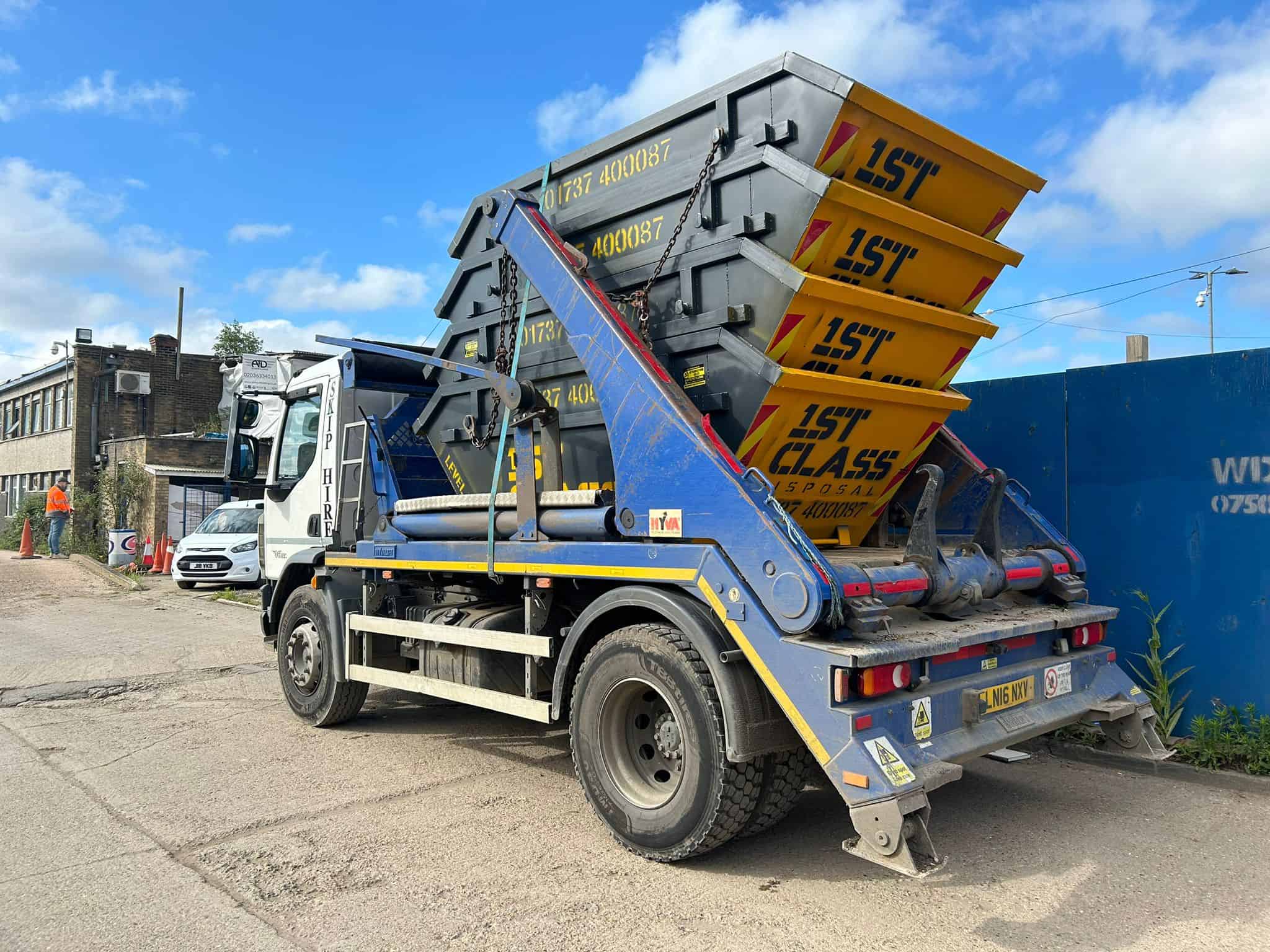Size matters when it comes to selecting the perfect skip for your Surrey project. Choosing the right skip size not only impacts your waste management efficiency but also ensures you’re not overloaded with excess waste or paying for unused capacity. To make the best decision, you need to assess the volume of waste you anticipate and consider the type of materials you’ll be disposing of. For a comprehensive overview of available options, visit Skip Sizes UK – Dimensions, Capacity and Usage Guide.

Understanding Skip Sizes
Before choosing a skip for your Surrey project, it’s crucial to understand the various sizes available and how they can accommodate different types of waste. Skips come in various dimensions, tailored to fit a range of project requirements, from small household clear-outs to large renovations. Knowing what size you need can save you time, money, and hassle when it comes to waste disposal.
Common Skip Sizes Available
With a variety of skip sizes on the market, you can typically find options ranging from 2-yard mini skips, suitable for small domestic jobs, up to 40-yard roll-on roll-off skips for large-scale commercial projects. Selecting the correct size is crucial to ensure efficient waste management and avoid excess costs.
How to Measure Your Project Waste
Measure the volume of your waste by estimating the total space it will occupy. Consider the size and nature of the materials—bulky items may require more space than loose waste. You can use a tape measure to calculate the dimensions of your waste pile and convert it into cubic yards for better comparison to skip sizes.
Plus, to accurately gauge your project waste, consider breaking down large items to maximise space, and keep in mind the weight of your waste, as heavier materials might require a smaller skip to comply with weight limits. Using a formula to calculate volume—length × width × height—will give you a clearer idea of how much waste you need to dispose of, guiding you to choose the appropriate skip size effectively.

Factors to Consider When Choosing a Skip
Any decision regarding the size of your skip should take into account several factors that can influence your choice. These include:
- Your type of project
- The volume of waste
- The type of waste
- The duration of the project
After evaluating these factors, you will be better equipped to select a skip that meets your needs.
Type of Waste
Factors that affect the type of skip you need include the kind of materials you plan to dispose of. Certain skips are designated for specific waste types such as construction debris, garden waste, or general household rubbish. Understanding these classifications will help ensure your waste is disposed of properly and legally.
Duration of Project
You need to consider the length of time your project will last. The duration can impact the size of skip you require, especially if you anticipate an ongoing accumulation of waste. Depending on your timeline, a larger skip may be necessary to accommodate your project’s peak waste generation.
To effectively manage your waste, it is vital to estimate the total duration of your project. If it is a long-term endeavour, you may find that a smaller skip needs frequent emptying, leading to increased costs and disruption. Conversely, a larger skip may be more efficient as it reduces the need for multiple collections while ensuring that your project runs smoothly. Always choose a skip size that allows for a safe margin to avoid overfilling and potential hazards.
Tips for Selecting the Right Skip Size
Some factors to consider when choosing the right skip size for your project include:
- Your type of project
- The type of waste you will be disposing of
- The volume of waste generated
- Space availability on your site
- Your budget
Thou should evaluate these aspects to make an informed decision on the appropriate skip size.
Estimating Volume of Waste
Waste estimation is key to choosing the correct skip size. Consider the amount of rubbish created during your project and estimate its volume in cubic yards or cubic metres. Collectively, you can visually assess your items, keeping in mind that bulky items like furniture occupy more space compared to smaller waste materials. Be realistic about your calculations to avoid unnecessary costs or insufficient capacity.
Avoiding Overloading
If you’re not careful, overloading your skip can lead to problems. It’s vital to ensure that you only fill the skip to the marked level to prevent any penalties or hazardous situations during collection.
Plus, overloading can create serious safety hazards, as overweight skips may spill debris or cause damage during transport. Additionally, exceeding the weight limit can result in extra charges or even refusal of collection by the skip hire company. To maintain safety and avoid fines, ensure your skip is balanced and within the legal weight limits.
The Importance of Local Regulations
For any project in Surrey, understanding local regulations is crucial. Authorities have specific rules regarding waste disposal, which can impact your choice of skip size. Compliance not only ensures your project proceeds smoothly but also helps avoid potential fines. Knowing the regulations can save you time and money in the long run, making it vital to research thoroughly before selecting your skip.
Permits and Restrictions
Clearly, you must consider whether you need a permit to place a skip on a public road or pavement. Local councils often have their own guidelines, and failing to obtain the necessary permits may lead to fines or penalties. Always check with your local authority before proceeding.
Placement Considerations
The placement of your skip can significantly affect the efficiency of your project. You need to choose a location that is both accessible for collection and does not obstruct pedestrian or vehicular traffic. Ensure that you are not violating any local regulations by placing your skip in a way that could impede emergency services or pose a danger to passers-by.
Placement plays a vital role in the success of your waste management strategy. Ideally, you should place your skip on a solid, level surface to prevent it from tipping over and causing damage or injury. Additionally, ensure there is sufficient space around the skip for collection trucks to manoeuvre easily, reducing the risk of delays. By choosing the right spot, you can enhance safety whilst also making your project run more efficiently.
Cost Considerations for Different Skip Sizes
Your choice of skip size will significantly affect your overall project budget. Smaller skips generally come at a lower price, making them ideal for minimal waste disposal. However, opting for a larger skip might be more economical in the long term if you anticipate a substantial amount of waste. It’s vital to balance your immediate costs with potential extra charges from overfilling smaller skips.
Pricing Structures
The costs associated with skip hiring can vary based on size, duration, and location. Smaller skips typically have a lower base price, while larger skips may incur higher fees. Additionally, keep in mind that some companies offer discounts for longer hire periods or bulk transactions, so it’s wise to inquire about different pricing structures before making your choice.
Budgeting for Waste Disposal
To effectively manage your finances, it’s important to take into account all costs associated with waste disposal. This includes hiring the skip itself, along with any add-on fees for weight limits or extended rental periods.
This budgeting process also involves anticipating potential *extra charges*. For instance, if your skip exceeds weight limits, you may face significant penalties. Consider the size of your project and *projected waste load*, as accurately estimating this can save you from overspending. Additionally, some companies provide *fixed-rate options* that include all associated costs, allowing you to stay within your budget while eliminating surprises.
Additional Resources for Waste Management
Not all waste management concerns can be addressed solely through choosing the right skip size. However, accessing comprehensive resources can enhance your understanding of responsible waste disposal and local regulations in Surrey. You’ll find valuable insights on local services, recycling options, and special waste categories that require specific handling, ensuring you remain compliant and environmentally conscious.
Local Waste Management Services
With a variety of local waste management services available, you can easily find a provider that meets your needs. Surrey boasts numerous companies offering specialised services tailored to residential, commercial, and construction waste. By reaching out to these local experts, you can gain personalised advice on waste disposal and recycling and ensure your project runs smoothly.
Online Calculators and Tools
Tools such as online calculators can simplify your skip size selection process.
Local waste management websites often feature interactive calculators designed to help you estimate the volume of waste your project will generate. By inputting key details, such as the type of materials you need to dispose of and the quantity, these tools can recommend the appropriate skip size for your needs. This convenient resource provides a quick reference point, allowing you to make informed decisions while ensuring efficient waste disposal.
Conclusion
The key to selecting the right skip size for your Surrey project lies in understanding the volume of waste you will generate. Evaluating your materials and planning accordingly will ensure you choose a skip that fits your needs without incurring unnecessary costs. For further guidance, you can refer to this informative resource on Choosing the Right Skip Sizes for Your Project. This will help you make an informed decision and streamline your project efficiently.
FAQ
Q: How do I determine what size skip I need for my project?
A: To determine the appropriate skip size, consider the volume of waste you expect to generate. An accurate assessment involves estimating the type of waste and calculating its volume. For example, household renovations might need a smaller 4-yard skip, while larger construction tasks may require an 8-yard or even a 12-yard skip. Additionally, consulting with a skip hire company can provide valuable insight based on their experience with similar projects.
Q: What types of skips are available for hire in Surrey?
A: In Surrey, you can find various skip sizes ranging from mini skips (2-3 yards) suitable for small clean-ups, to midi skips (4-5 yards) for medium-sized projects. Larger options include builders’ skips (6-8 yards) and roll-on, roll-off skips (up to 40 yards) for significant commercial waste. Each type is designed for specific waste removal needs, so choosing based on your project scope is important.
Q: Are there any restrictions for what can be placed in my skip?
A: Yes, there are restrictions on what can be placed in skips. Hazardous materials such as asbestos, medical waste, batteries, and certain types of tyres are generally prohibited. Additionally, some skips cannot accept mixed waste. Always check with your skip hire provider for a list of acceptable items and guidelines to ensure compliance with local regulations.
Q: How long can I keep the skip on my property?
A: The duration for which you can keep a skip largely depends on the terms set by the skip hire company. Typically, most companies offer rental periods ranging from a few days to a couple of weeks. If you require the skip for a longer period, you may be able to arrange an extension, often for an additional fee. However, it’s imperative to verify parking regulations if the skip is placed on a public road.
Q: What should I consider if I need multiple skips for my project?
A: If your project involves significant waste generation, you might need multiple skips. In this case, consider the size of each skip, the estimated waste volume, and how your waste will be sorted. Hiring various skip sizes can be cost-effective; however, it’s advisable to communicate your needs with the skip hire company to optimise your service and possibly negotiate discounts for multiple hires.


